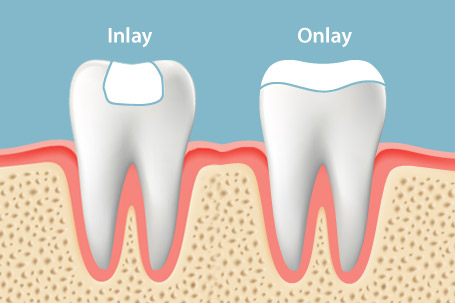Why Are Inlays Used?
The dentist may prescribe you with a dental inlay because you may be suffering from following conditions.
- Chipped or cracked teeth which are difficult or impossible to repair by dental fillings or other dental restoration procedures.
- Decaying of the tooth due to cavities that occur when bacteria damages the teeth. Dental inlays are suitable for both deep and severe decays.
Procedure Of Placing Dental Inlays
The dental inlays procedure will start from when you visit the dentist for a consultation and he recommends you with a dental inlay for the treatment. He will look into your medical history. It is important that you mention any other medication you are taking for any of the treatments.
The dental inlay placement procedure may vary from individual to individual and the consultant. However,the majority of the steps will remain the same and are as follows.
- The very first day of the treatment starts with the dentist reviewing the condition of the teeth and explaining the procedure to you. He will inform you of any potential risk if any follows depending upon the severity of the treatment.
- The dentist will apply a local numbing gel to the area where the injection is supposed to be injected. At times there is no need of anesthesia to accomplish the inlay placement procedure. however, if a local anesthesia is given then you will feel a slight prick in the gum and then the area will go numb for a couple of hours.
- You may feel a bit anxious about the whole procedure, he may prescribe you a low sedation pill so that you may get relaxed and not panic during the procedure.
- Once the area is numbed, the dentist will add rubber dental dams to your mouth. It helps in preventing the patient to swallow decay and other material that is scraped out from the tooth. They also protect the patient’s cheek and tongue from getting injured by any dental instruments.
- After proper space is achieved for working then the dentist will scrap out all the decay with a dental instrument. This helps to remove the infected part of the tooth so that a part of the healthy tooth becomes prominent that helps withthe insertion of inlays.
- Moreover,the dentist applies caries which is a detection dye to show less obvious decay. This helps the dentist in cleaning the tooth surface without harming the tooth. Chlorhexidine a disinfection solution is used by some of the dentists which kills bacteria in the tooth and helps in its removal.
- If the infection has spread deep into the tooth then he may add a liner or base to the pulp of the tooth.
- After this, an impression is taken of the scrapped tooth. Which will be used to make a similar mould for the tooth.
- Using an elastic bite paste an interocclusal record is taken of the teeth structure.
- A temporary filling will be added to the tooth until the next appointment and the mould will be sent to the laboratory for making the inlays.
- However, you will be asked to wait if the inlays are moulded in office and after they are prepared they are inserted as caps on the tooth left behind
- If your inlays were made in the lab then you will be given an appointment. And on the next appointment, the inlays will be placed.
- Finally, on the day, the dentist may give you a shot of anesthesia again. The filling will be removed and the inlays will be cemented on the tooth.
The dentist will inform you about any dental care routine you need to follow or give you an appointment for next visit to check if the inlays are fine.
 Author Name: Darshan Shah
Author Name: Darshan ShahAuthor Bio :
Darshan Shah is a young serial entrepreneur, digital marketer and blogger. He’s enthusiastic about creating blogs and writes creative content





